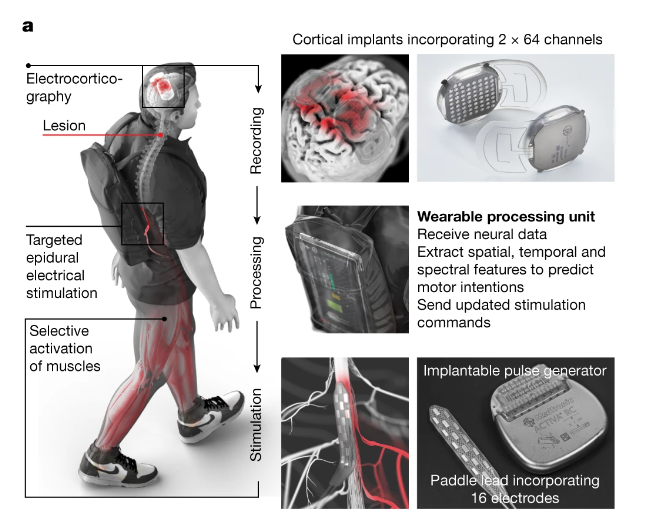Digital nerve bridge allows man with spinal cord injury to walk again
Without an understanding of the underlying technology, modern science is indistinguishable from magic. This time no messianic figure with long hair but a scientist who says: get up and walk. And guess what, it still works.
Contents
Bluetooth bridge averts spinal cord injury
His name is Gert-Jan Oskam. 12 years ago, in 2011, he ended up in hospital after a serious cycling accident. The diagnosis was disappointing: a partial spinal cord injury. Partly is a nice way to put it. Gert-Jan broke his neck. The resulting spinal cord injury may be called incomplete, but it must have offered little consolation. He was paralyzed from the neck down. Rehabilitation made little progress. Eight months later, he couldn’t get further than a few steps behind a walker.
Fortunately for Gert-Jan, a group of Swiss neurosurgeons came up with a solution: a digital connection that bypasses the break in the nerve. Of course that was not easy. Gert-Jan has been participating in a study since 2016. During this study, his spinal cord was stimulated with electrodes. Unfortunately, it did not provide the results hoped for, progress stagnated. The current study for which the digital bridge has been placed is a follow-up study to the one from 2016.
A few implants and a processor
The system is deceptively simple in its simplicity. Two implants of 64 electrodes each are implanted on the sensorimotor cortex, the part of the brain responsible for controlling voluntary movements. These implants record the signals that the brain tries to send to the paralyzed muscles. A processor interprets these signals and then sends them to an implanted pulse generator in the lower back. In this way the nerve fracture is bypassed.
Test, test and more test
As any toddler can tell you, walking isn’t that easy. With each step, a large number of muscles are controlled in a complex way. Hence, one started with simply lifting a single leg from a standing position. Then crutches came in handy. That also worked.
One of the most important things to determine was who initiated the moves, Gert-Jan or the processor behind the bridge. To this end, every movement was checked to see whether it matched Gert-Jan’s intentions. Just about every resulting stride was measured to see if they matched the stride of someone without spinal cord injury.
The results don’t lie. With the bridge switched on, Gert-Jan can climb stairs, climb and descend steep slopes, and perhaps most importantly, just walk independently in a normal way. The implants have now been in for about a year and have continued to do their job without any significant decay over that time. In fact, it seems that as the brain learns to deal better with the implants, the whole thing has only started to do its job better.
Lasting results
Initially, expanding the bridge resulted in an immediate loss of control. The special thing here changed as the research progressed. When the bridge is now switched off, Gert-Jan will no longer completely lose mobility. It seems that the bridge does more than just that; function as a bridge. The nervous system seems to learn from the temporary recovery. When the bridge is now off, Gert-Jan can walk reasonably normally with crutches, something that was previously out of the question. The preliminary conclusion is therefore that the digital bridge offers a kind of framework to restore natural control over movements after a paralysis.
As with any scientific study, it is wise to wait until a thorough peer review has taken place. However, the results are more than promising. It is a beautiful reminder of the fact that humans are capable of making wonderful things.



